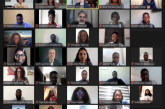By Isabel Papadakis, Head: Africa Industry Value Advisory at SAP
Want to achieve quick time-to-value on your digital transformation efforts while still building toward greater future capabilities? This is what you need to know.
NAIROBI, Kenya, March 23, 2021 -/African Media Agency(AMA)/-Organisations have experienced immense disruption over the past year. Many have had to reinvent their operating models, their product or service offerings and, in some cases, even their entire business model. In the face of such disruption, there is no single solution for every businesses’ ills.
The impact of the COVID-19 pandemic on organisations was immediate and in many respects irreversible. As lockdowns confined office workers to their homes, organisations suddenly needed the agility to enable remote work and reengineer processes to ensure the business could continue operating.
Catalyst for digital transformation
Organisations fortunate enough to be far along their digital transformation journeys could arguably adapt more easily to the disruption. For others, the pandemic has been a catalyst for accelerated digital transformation.
In a global survey conducted by McKinsey, executives said the pandemic had accelerated the digitisation of their supply chain, customer interactions and internal operations by three to four years.
For most organisations, the initial impact of the pandemic forced the quick adoption of temporary solutions. Tellingly, the executives in the McKinsey survey said they expect most of these solutions to be long-lasting.
What does this tell us about how organisations should approach digital transformation in our still-evolving business environment?
For one, organisations are under pressure to adapt to immediate changes, but have to balance this with long-term priorities.

Meeting short-term pressures
Business conditions are challenging right now. Organisations need the immediate ability to leverage technology to improve productivity, drive innovation or unlock new revenue streams. There is great urgency in achieving certain business outcomes – enabling effective remote workforce management, or increased business productivity, for example – and technology plays a major role in achieving these outcomes.
There is also great pressure to achieve quick time-to-value for any investment into new digital technologies. Cloud-based projects provide opportunities to bring organisational capabilities more in line with modern customer demands, especially in terms of accessibility, cost-efficiency and other changes accelerated by the pandemic.
While every business may be unique, the challenges they face are often similar. Off-the-shelf technology solutions are often sufficient to meet business challenges and can further help contain the high cost and time investment of customisation.
Building future competitiveness
But there is also the pressing need to build capabilities that will help the business succeed into the future. The arrival of 5G connectivity, the growing volume of sensors in IoT-based deployments, the power of artificial intelligence and predictive analytics: these are all accelerators toward a new world of innovation and competitiveness. Organisations cannot afford to focus only on short-term productivity gains and sacrifice their long-term innovation capabilities.
Instead, organisations need to identify immediate and long-term growth and innovation opportunities that are unique to them, and then bring in partners and technology providers than can help build capabilities to capitalise on those opportunities.
Toward intelligent enterprise capabilities
The ultimate aim of modern digital transformation is for organisations to become intelligent enterprises, which have the capability to seamlessly integrate emerging technologies with a powerful digital core to continuously turn data into insights.
Intelligent enterprises represent a step-change in the evolution of how technology is used to drive business outcomes and innovation, and can accelerate innovation, increase productivity and deliver outstanding customer and employee experiences. Becoming an intelligent enterprise is essentially an insurance policy against future disruption.
Organisations leading in the journey toward becoming intelligent enterprises have embarked on high-value short-term projects that help them deal with immediate challenges without losing sight of the transformation outcomes that will support their future growth. It is a careful balancing act but one that is essential: simply focusing on short-term solutions without some element of future-proof testing may result in sunk costs and missed opportunities.
The introduction of business-transformation-as-a-service with the launch of “RISE with SAP” this year is simplifying the journey that organisations need to take toward becoming intelligent enterprises. RISE helps organisations unlock the full value of their transformations sooner, helping build greater agility, no matter where organisations are on their digital transformation journeys.
Organisations have had a rocky time adapting to the disruption of the COVID-19 pandemic. For many, it was a catalyst toward greater adoption of digital technologies. But the disruptive environment of 2020 remains: organisations have to build capabilities that will enable them to continue adapting to further disruption. And now with new tools that make the journey toward becoming intelligent enterprises easier, organisations can leverage the latest technologies to ensure they remain successful no matter what comes their way.
Distributed by African Media Agency (AMA) on behalf of SAP Africa.
Visit the SAP News Center. Follow SAP on Twitter at @SAPNews.
About SAP
SAP’s strategy is to help every business run as an intelligent enterprise. As a market leader in enterprise application software, we help companies of all sizes and in all industries run at their best: 77% of the world’s transaction revenue touches an SAP® system. Our machine learning, Internet of Things (IoT), and advanced analytics technologies help turn customers’ businesses into intelligent enterprises. SAP helps give people and organizations deep business insight and fosters collaboration that helps them stay ahead of their competition. We simplify technology for companies so they can consume our software the way they want – without disruption. Our end-to-end suite of applications and services enables business and public customers across 25 industries globally to operate profitably, adapt continuously, and make a difference. With a global network of customers, partners, employees, and thought leaders, SAP helps the world run better and improve people’s lives. For more information, visit www.sap.com.
# # #
Any statements contained in this document that are not historical facts are forward-looking statements as defined in the U.S. Private Securities Litigation Reform Act of 1995. Words such as “anticipate,” “believe,” “estimate,” “expect,” “forecast,” “intend,” “may,” “plan,” “project,” “predict,” “should” and “will” and similar expressions as they relate to SAP are intended to identify such forward-looking statements. SAP undertakes no obligation to publicly update or revise any forward-looking statements. All forward-looking statements are subject to various risks and uncertainties that could cause actual results to differ materially from expectations. The factors that could affect SAP’s future financial results are discussed more fully in SAP’s filings with the U.S. Securities and Exchange Commission (“SEC”), including SAP’s most recent Annual Report on Form 20-F filed with the SEC. Readers are cautioned not to place undue reliance on these forward-looking statements, which speak only as of their dates.
© 2020 SAP SE. All rights reserved.
SAP and other SAP products and services mentioned herein as well as their respective logos are trademarks or registered trademarks of SAP SE in Germany and other countries. Please see https://www.sap.com/copyright for additional trademark information and notices.
Note to editors:
To preview and download broadcast-standard stock footage and press photos digitally, please visit www.sap.com/photos. On this platform, you can find high resolution material for your media channels. To view video stories on diverse topics, visit www.sap-tv.com. From this site, you can embed videos into your own Web pages, share video via email links, and subscribe to RSS feeds from SAP TV.
For customers interested in learning more about SAP products:
Global Customer Center: +49 180 534-34-24
United States Only: 1 (800) 872-1SAP (1-800-872-1727)
For more information, press only:
Delia Sieff, SAP Africa, +27 (11) 235 6000, [email protected]
Adam Hunter, SAP Africa, +27 (711) 787 035, [email protected]
The post How to navigate digital transformation in 2021 appeared first on African Media Agency.








